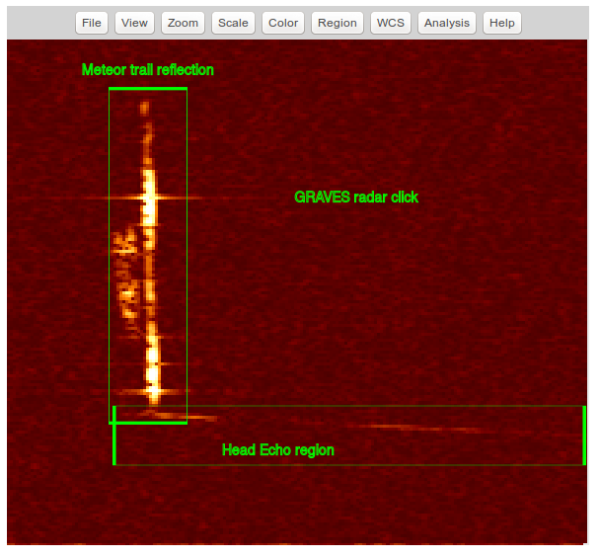This is an old revision of the document!
Table of Contents

(remove this paragraph once the translation is finished)
Bolidozor data outputs
The data produced by the detection stations are sent to the main data server running a JS9browser tool. It enables to view the visual portion of the data. Statistical data are available on Bolidozor RealTime web.
There are several types of files among data records:
- Periodic previews (XXXXX_snap.fits)
- Computed spectral previews of meteors (XXXX_met.FITS)
- Raw ADC sample records from receiver (XXXX_raws.fits)
- Metadata records (XXX.csv)
JS9 web viewer enables viewing only the first two records. A specialised application is required to see the rest of the records. The description of how the data files are sorted can be found on directory convenctions webpage. All the time records are stored either as Unix time or UTC.
Records generation
The records are generated by a software running on the detection stations. Majority of data are produced by Radio-observer software. Other auxiliary meta-data outputs are generated by a software maintaining an integrity of data flow from the stations.
Spectral records description
Visual records, viewable by JS9browser, have a form of a so-called spectrograms, showing frequency on one and time on the other axis.
In our case:
- Vertical axis shows the time (oldest data being at the bottom)
- Horizontal axis shows the frequency (lowest frequency on the left)
The radar emitting frequency corresponds to the vertical line Frekvence na které vysílá radar odpovídá svislici proložené průměrnými pozicemi stop meteorů. Což je signál, který je statický a proto má téměř nulový Dopplerův frekvenční posuv.
Ve spodní části záznamu vidíme head-echo, což je signál, který vždy začíná na vyšších frekvencích než stopa meteoru. Head-echo je signál vznikající odrazem od ionizované plazmy před meteoroidem během jeho průletu. Jde proto o pohybující se objekt. A jeho signál má proto v důsledku značné rychlosti (až desítky km/s) velký dopplerovský posuv, který během průletu prochází nulou (v místě nejkratšího součtu vzdáleností vysílač → meteor → přijímač). Některé meteory head-echo signál nemají, protože geometrie průletu nedovoluje odraz do přijímací stanice. Jiné meteory naopak mají head-echo, které pokračuje i za bodem nulového dopplerovského posuvu.
Na oblast signálu head-echa navazuje oblast statického odrazu od stopy meteoru. Která mění svojí intenzitu v čase. Změna intenzity je jednak způsobena postupnou rekombinací plazmové stopy meteoru a periodické změny intenzity jsou způsobeny prostorovou modulací signálu radaru.

